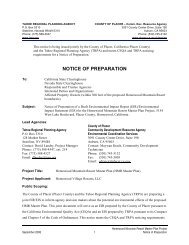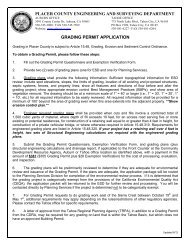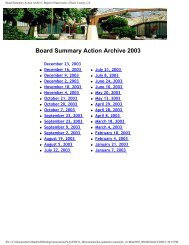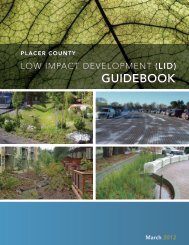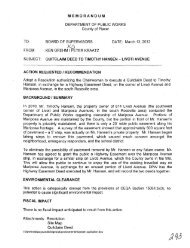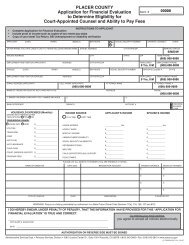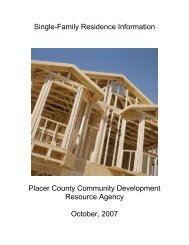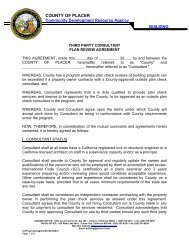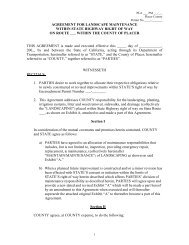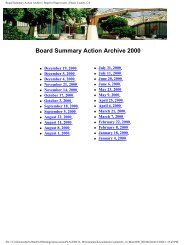Fuel Procurement Plan for the Lake Tahoe Basin - Placer County ...
Fuel Procurement Plan for the Lake Tahoe Basin - Placer County ...
Fuel Procurement Plan for the Lake Tahoe Basin - Placer County ...
- No tags were found...
Create successful ePaper yourself
Turn your PDF publications into a flip-book with our unique Google optimized e-Paper software.
EXECUTIVE SUMMARY<strong>Placer</strong> <strong>County</strong> has retained TSS Consultants (TSS) to complete a fuel availabilityassessment and develop a fuel procurement plan <strong>for</strong> <strong>the</strong> <strong>Lake</strong> <strong>Tahoe</strong> <strong>Basin</strong> BiomassEnergy (LTBBE) facility project. This fuel assessment and procurement plan isconsistent with task 7.0 of <strong>the</strong> U.S. Department of Energy (DOE) award No. DE-FG36-08GO88026. Additional investigation of long-term sustainable supply obtainable via<strong>for</strong>est stewardship contracts and o<strong>the</strong>r viable contracting opportunities was conducted toassist in determining if successful deployment of a one to three megawatt (MW) woodybiomass-to-energy facility in <strong>the</strong> Kings Beach area of <strong>Lake</strong> <strong>Tahoe</strong> can be accomplished.Such a facility would benefit hazardous <strong>for</strong>est fuels reduction programs in <strong>the</strong> <strong>Lake</strong><strong>Tahoe</strong> <strong>Basin</strong> (LTB) and is consistent with <strong>Placer</strong> <strong>County</strong>’s Strategic <strong>Plan</strong> <strong>for</strong> WildfireProtection and Biomass Utilization.The LTBBE facility will also provide a ready alternative to <strong>the</strong> current preferred disposalmethod of piling and burning material removed as a byproduct of hazardous fuelstreatment activities. The net reduction in air emissions (e.g., particulate matter, CO,NOx, SOx) by diverting this material into a controlled combustion system equipped withmaximum achievable control technology will be significant. As fire districts, landmanagement agencies and local residents ramp up fuels treatment activities (as planned),it is anticipated that significant volumes of biomass material will be generated as abyproduct.From June through August 2010, TSS conducted a comprehensive review of biomassmarkets, resource availability and current demand <strong>for</strong> biomass feedstocks in <strong>the</strong> greater<strong>Lake</strong> <strong>Tahoe</strong> region. This fuel assessment utilized a 40-year planning horizon, as this is<strong>the</strong> projected service life of <strong>the</strong> LTBBE facility. Only strategic, sustainable fuelresources consistent with <strong>the</strong> project objectives and compliant with state (Cali<strong>for</strong>niaEnvironmental Quality Act, State of Nevada Title 47 Regulations), regional (<strong>Tahoe</strong>Regional <strong>Plan</strong>ning Agency rules and guidelines), and federal (National EnvironmentalPolicy Act) regulations were considered as potentially available fuel.Results of this fuel assessment concur that <strong>the</strong>re is more than sufficient biomass materialavailable to sustain a one to three MW biomass power generation facility sited at KingsBeach, Cali<strong>for</strong>nia. TSS found that <strong>the</strong>re is approximately 112,440 bone dry tons (BDT)per year of biomass fuel practically available within a 30-mile radius of Kings Beach.Current demand amounts to about 40,350 BDT per year resulting in a net availability of72,090 BDT per year.Assuming that <strong>the</strong> LTBBE is scaled at two MW of electrical output and utilizes 20,000BDT of biomass fuel annually, <strong>the</strong>n a 3.6:1 fuel cover ratio exists. <strong>Fuel</strong> coverage ratiorepresents <strong>the</strong> net availability of fuel relative to new demand in <strong>the</strong> marketplace. Thehigher <strong>the</strong> fuel coverage ratio, <strong>the</strong> more fuel is <strong>for</strong>ecast to be available. Private financialmarkets and project developers prefer a fuel coverage ratio of 2:1 or more <strong>for</strong> newbioenergy projects.<strong>Fuel</strong> <strong>Procurement</strong> <strong>Plan</strong> <strong>for</strong> <strong>the</strong> <strong>Lake</strong> <strong>Tahoe</strong> <strong>Basin</strong> Biomass Energy Facility 1TSS Consultants




